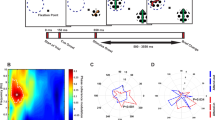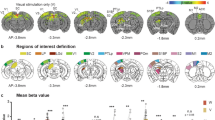Abstract
The role of primary visual cortex (V1) in determining the contents of perception is controversial. Human functional magnetic resonance imaging (fMRI) studies of perceptual suppression have revealed a robust drop in V1 activity when a stimulus is subjectively invisible. In contrast, monkey single-unit recordings have failed to demonstrate such perception-locked changes in V1. To investigate the basis of this discrepancy, we measured both the blood oxygen level–dependent (BOLD) response and several electrophysiological signals in two behaving monkeys. We found that all signals were in good agreement during conventional stimulus presentation, showing strong visual modulation to presentation and removal of a stimulus. During perceptual suppression, however, only the BOLD response and the low-frequency local field potential (LFP) power showed decreases, whereas the spiking and high-frequency LFP power were unaffected. These results demonstrate that the coupling between the BOLD and electrophysiological signals in V1 is context dependent, with a marked dissociation occurring during perceptual suppression.
This is a preview of subscription content, access via your institution
Access options
Subscribe to this journal
Receive 12 print issues and online access
$209.00 per year
only $17.42 per issue
Buy this article
- Purchase on Springer Link
- Instant access to full article PDF
Prices may be subject to local taxes which are calculated during checkout







Similar content being viewed by others
References
Blake, R. & Logothetis, N.K. Visual competition. Nat. Rev. Neurosci. 3, 13–21 (2002).
Crick, F. & Koch, C. Are we aware of neural activity in primary visual cortex? Nature 375, 121–123 (1995).
Polonsky, A., Blake, R., Braun, J. & Heeger, D.J. Neuronal activity in human primary visual cortex correlates with perception during binocular rivalry. Nat. Neurosci. 3, 1153–1159 (2000).
Tong, F. & Engel, S.A. Interocular rivalry revealed in the human cortical blind-spot representation. Nature 411, 195–199 (2001).
Haynes, J.D. & Rees, G. Predicting the stream of consciousness from activity in human visual cortex. Curr. Biol. 15, 1301–1307 (2005).
Haynes, J.D., Deichmann, R. & Rees, G. Eye-specific effects of binocular rivalry in the human lateral geniculate nucleus. Nature 438, 496–499 (2005).
Wunderlich, K., Schneider, K.A. & Kastner, S. Neural correlates of binocular rivalry in the human lateral geniculate nucleus. Nat. Neurosci. 8, 1595–1602 (2005).
Lee, S.H., Blake, R. & Heeger, D.J. Traveling waves of activity in primary visual cortex during binocular rivalry. Nat. Neurosci. 8, 22–23 (2005).
Lee, S.H. & Blake, R. V1 activity is reduced during binocular rivalry. J. Vis. 2, 618–626 (2002).
Leopold, D.A. & Logothetis, N.K. Activity changes in early visual cortex reflect monkeys' percepts during binocular rivalry. Nature 379, 549–553 (1996).
Leopold, D.A., Maier, A., Wilke, M. & Logothetis, N.K. Binocular rivalry and the illusion of monocular vision. in Binocular Rivalry and Perceptual Ambiguity (eds. Alais, D. & Blake, R.) (MIT Press, Cambridge, Massachusetts, 2004).
Gail, A., Brinksmeyer, H.J. & Eckhorn, R. Perception-related modulations of local field potential power and coherence in primary visual cortex of awake monkey during binocular rivalry. Cereb. Cortex 14, 300–313 (2004).
Wilke, M., Logothetis, N.K. & Leopold, D.A. Local field potential reflects perceptual suppression in monkey visual cortex. Proc. Natl. Acad. Sci. USA 103, 17507–17512 (2006).
Tong, F. Primary visual cortex and visual awareness. Nat. Rev. Neurosci. 4, 219–229 (2003).
Tong, F., Meng, M. & Blake, R. Neural bases of binocular rivalry. Trends Cogn. Sci. 10, 502–511 (2006).
Wilke, M., Logothetis, N.K. & Leopold, D.A. Generalized flash suppression of salient visual targets. Neuron 39, 1043–1052 (2003).
Bonneh, Y.S., Cooperman, A. & Sagi, D. Motion-induced blindness in normal observers. Nature 411, 798–801 (2001).
Wolfe, J.M. Reversing ocular dominance and suppression in a single flash. Vision Res. 24, 471–478 (1984).
Maier, A., Logothetis, N.K. & Leopold, D.A. Context-dependent perceptual modulation of single neurons in primate visual cortex. Proc. Natl. Acad. Sci. USA 104, 5620–5625 (2007).
Logothetis, N.K. & Schall, J.D. Neuronal correlates of subjective visual perception. Science 245, 761–763 (1989).
Gauthier, C. & Hoge, R.D. BOLD-perfusion coupling during monocular and binocular stimulation. Int. J. Biomed. Imaging published online, 10.1155/2008/628718 (2 March 2008).
Logothetis, N.K. The neural basis of the blood-oxygen-level–dependent functional magnetic resonance imaging signal. Phil. Trans. R. Soc. Lond. B 357, 1003–1037 (2002).
Mitchell, J.F., Sundberg, K.A. & Reynolds, J.H. Differential attention-dependent response modulation across cell classes in macaque visual area V4. Neuron 55, 131–141 (2007).
Iadecola, C. Neurovascular regulation in the normal brain and in Alzheimer's disease. Nat. Rev. Neurosci. 5, 347–360 (2004).
Logothetis, N.K. The underpinnings of the BOLD functional magnetic resonance imaging signal. J. Neurosci. 23, 3963–3971 (2003).
Niessing, J. et al. Hemodynamic signals correlate tightly with synchronized gamma oscillations. Science 309, 948–951 (2005).
Viswanathan, A. & Freeman, R.D. Neurometabolic coupling in cerebral cortex reflects synaptic more than spiking activity. Nat. Neurosci. 10, 1308–1312 (2007).
Super, H., Spekreijse, H. & Lamme, V.A. Two distinct modes of sensory processing observed in monkey primary visual cortex (V1). Nat. Neurosci. 4, 304–310 (2001).
Lamme, V.A., Super, H., Landman, R., Roelfsema, P.R. & Spekreijse, H. The role of primary visual cortex (V1) in visual awareness. Vision Res. 40, 1507–1521 (2000).
Posner, M.I. & Gilbert, C.D. Attention and primary visual cortex. Proc. Natl. Acad. Sci. USA 96, 2585–2587 (1999).
Maier, A., Aura, C. & Leopold, D.A. Laminar differences in perceptual modulation of V1 local field potentials. Soc. Neurosci. Abstr. 451.12 (2007).
Shmuel, A. & Leopold, D.A. Neuronal correlates of spontaneous fluctuations in fMRI signals in monkey visual cortex: Implications for functional connectivity at rest. Hum. Brain Mapp. 29, 751–761 (2008).
Mukamel, R. et al. Coupling between neuronal firing, field potentials and FMRI in human auditory cortex. Science 309, 951–954 (2005).
Nir, Y. et al. Coupling between neuronal firing rate, gamma LFP and BOLD fMRI is related to interneuronal correlations. Curr. Biol. 17, 1275–1285 (2007).
Judge, S.J., Richmond, B.J. & Chu, F.C. Implantation of magnetic search coils for measurement of eye position: an improved method. Vision Res. 20, 535–538 (1980).
Mitz, A.R. A liquid-delivery device that provides precise reward control for neurophysiological and behavioral experiments. J. Neurosci. Methods 148, 19–25 (2005).
Gruetter, R. Automatic, localized in vivo adjustment of all first- and second-order shim coils. Magn. Reson. Med. 29, 804–811 (1993).
Mansfield, P. Multi-planar image formation using NMR spin echoes. J. Phys. C Solid State Phys. 10, L55–L58 (1977).
Cox, R.W. Software for analysis and visualization of functional magnetic resonance neuroimages. Comput. Biomed. Res. 29, 162–173 (1996).
Leopold, D.A., Murayama, Y. & Logothetis, N.K. Very slow activity fluctuations in monkey visual cortex: implications for functional brain imaging. Cereb. Cortex 13, 422–433 (2003).
Acknowledgements
We would like to thank G. Dold, D. Ide, N. Nichols and T. Talbot, as well as K. Smith, N. Phipps and J. Yu for technical assistance. We also thank H. Merkle for extensive guidance on the design and fabrication of radio frequency coils, R. Cox for assistance with magnetic resonance image alignment, D. Sheinberg for help with the stimulus software, K. King and C. Brewer for auditory testing and ear plug manufacture, W. Vinje for help with the multi-contact electrodes, K. Tanji, A.H. Bell and Z. Saad for help with the fMRI analysis, and S. Guderian, M. Schmid and K.-M. Mueller for discussions. This work was supported by the Intramural Research Programs of the National Institute of Mental Health, the National Institute of Neurological Disorders and Stroke and the National Eye Institute.
Author information
Authors and Affiliations
Contributions
A.M., M.W. and D.A.L. designed the experiments. A.M., M.W., C.A., C.Z., F.Q.Y. and D.A.L. contributed to the fMRI experiments. A.M., M.W. and C.A. carried out the electrophysiological testing, and M.W. collected the psychophysical data. A.M. analyzed the fMRI and electrophysiological data. A.M. and D.A.L. wrote the paper.
Corresponding author
Supplementary information
Supplementary Text and Figures
Supplementary Figures 1–9 and Supplementary Methods (PDF 1597 kb)
Rights and permissions
About this article
Cite this article
Maier, A., Wilke, M., Aura, C. et al. Divergence of fMRI and neural signals in V1 during perceptual suppression in the awake monkey. Nat Neurosci 11, 1193–1200 (2008). https://doi.org/10.1038/nn.2173
Received:
Accepted:
Published:
Issue Date:
DOI: https://doi.org/10.1038/nn.2173
This article is cited by
-
Alternative female and male developmental trajectories in the dynamic balance of human visual perception
Scientific Reports (2022)
-
Primate ventral striatum maintains neural representations of the value of previously rewarded objects for habitual seeking
Nature Communications (2021)
-
Reduced alpha amplitudes predict perceptual suppression
Scientific Reports (2021)
-
The extracellular matrix regulates cortical layer dynamics and cross-columnar frequency integration in the auditory cortex
Communications Biology (2021)
-
Visual Influences on Auditory Behavioral, Neural, and Perceptual Processes: A Review
Journal of the Association for Research in Otolaryngology (2021)



